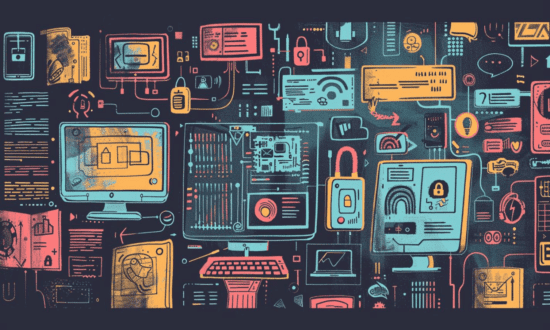Cybersecurity has moved to the top of every CIO’s agenda in the last few years as organizations in every industry battle to navigate an increasingly complex threat landscape. Adversaries are more well-funded and determined than ever, and their tools are growing in persistence and sophistication.
At the same time, the distributed workforces that arrived with the pandemic have widened the attack surface exponentially, introducing new vulnerabilities, and presenting attackers with a slew of new vectors to gain a foothold on corporate networks.
From sophisticated malefactors to opportunistic malware, there are many risks. In this blog, we’ll delve into the common vulnerabilities and risks that characterize the cybersecurity landscape and offer insights into measures that can be taken to avoid them.
Cloudy, With a Chance of Malware
Cloud computing might have revolutionized how data is stored, accessed, and processed, but it also introduced a host of vulnerabilities. Misconfigured cloud storage, weak access controls, and inadequate encryption protocols have exposed sensitive data to all sorts of unauthorized parties. Moreover, shared resources in multi-tenant environments create potential entry points for bad actors looking to compromise many users simultaneously.
Mitigating cloud vulnerabilities requires diligent configuration management, robust access controls, and continuous monitoring to promptly detect and respond to anomalies. In addition, companies should adopt a shared responsibility model which outlines the distribution of security responsibilities between cloud service providers and their customers. In this model, CSPs are typically responsible for securing the underlying infrastructure, while customers are accountable for securing their data, applications, identities, and access controls within the cloud environment.
Once More Unto the Breach
Barely a day goes by without a new data breach hitting the headlines. Data breaches remain a clear and present danger to all businesses, with cybercriminals targeting organizations to steal valuable information such as personal identifiable information (PII), financial data, and intellectual property.
The repercussions of data breaches can be severe, including financial losses, reputational damage, and legal ramifications. There’s also the immeasurable loss of customer trust and confidence, and putting a price tag on it is impossible. Implementing encryption, adopting a defense-in-depth approach, and conducting regular security assessments are just some measures that can help mitigate the risk of data breaches.
What a Tangled Web We Weave
The proliferation of Internet of Things (IoT) devices has expanded the attack surface dramatically, creating an interconnected web of billions of devices, sensors, and connections. Unfortunately, many of these “things” were not designed with security in mind, and instead of having robust measures built in from the ground up, they have been tacked on as an afterthought.
Vulnerabilities in IoT devices can be exploited to launch large-scale distributed denial-of-service (DDoS) attacks, infiltrate networks, or compromise sensitive information. To combat this threat, manufacturers need to prioritize security by design, incorporating encryption, authentication mechanisms, and regular firmware updates to fortify these devices against myriad threats.
Texts, Lies, and Threats on the Go
While mobile devices have become indispensable tools for running our personal and business lives, they are also prime targets for malicious actors. Malware-laden apps, phishing scams, vishing, and network vulnerabilities can compromise the security of smartphones, leading to data theft, unauthorized access, and financial fraud.
Moreover, phones can easily be lost or stolen, and with them, a treasure trove of valuable personal and business data. Implementing mobile device management (MDM) solutions, enforcing strong authentication measures, and educating users about best security practices are critical steps to mitigate mobile device vulnerabilities. For businesses, robust BYOD policies can help protect networks from the risks associated with using personal devices to access business resources.
Hooking a Big Phish
Phishing attacks remain a thorn in the side of individuals and organizations alike. Leveraging cunning social engineering techniques, these threats deceive users into divulging sensitive information or clicking on malicious links that steal their login credentials or banking information. These links usually masquerade as legitimate websites and are so carefully crafted that they are able to defy all but the closest scrutiny.
Robust email filtering and multi-factor authentication can help thwart phishing attempts and mitigate the risk of unauthorized access. Moreover, user training that teaches individuals basic security hygiene, such as checking out link addresses before clicking on them and exercising general caution, is helpful, too.
A Digital Kidnapping Epidemic
Ransomware is another severe threat, encrypting critical data, locking down systems, and demanding the victim pony up a ransom payment for decryption keys. These attacks can cripple organizations, disrupt operations, and cause massive financial losses. Furthermore, ransomware variants continuously evolve, employing advanced encryption algorithms and evasion techniques to bypass security defenses.
The gangs behind ransomware are also evolving and are now using double, triple, and multi-extortion ransomware techniques, which, as the names suggest, use more than one layer of attack to persuade the victims to pay the ransom. Over and above encrypting files, this type of attack might include file exfiltration, distributed denial of service (DDoS) attacks, or extending the ransoms to third-party partners. If you’re unlucky, it could be all three.
Ensuring regular data backups, deploying endpoint security solutions, and conducting incident response drills are essential strategies to mitigate the impact of ransomware attacks.
A Host of Remote Possibilities
The shift towards remote work has introduced a slew of new cybersecurity vulnerabilities. The traditional company perimeter has blurred, and the attack surface has widened exponentially. Employees are accessing company networks and data from home, on the go, or at a coffee shop – environments that lack the robust security measures that corporate environments enjoy.
Organizations need to implement secure remote access solutions, enforce robust authentication methods, introduce tools such as passkeys to replace passwords, and, again, educate employees about remote work security best practices to lessen the risks that go hand in hand with remote work environments.
To Err is Human
Social engineering remains one of the most effective weapons in the attacker’s arsenal. To err is human, and cybercriminals know how to exploit our natural biases. Techniques such as pretexting, baiting, and tailgating manipulate people into divulging sensitive information or doing something that compromises security.
Employee training, awareness campaigns, and simulated phishing exercises are crucial components of a comprehensive defense strategy to protect users from clever social engineers.
Securing Connected Supply Chains
Extensive networks of third-party partners mark today’s business landscape. Collaboration with vendors and contractors introduces additional cybersecurity risks, as third-party entities may have access to sensitive data or systems. Weaknesses in vendor security practices, such as inadequate access controls or insufficient security protocols, can be exploited by attackers as a stepping stone to access a more high-value target.
Conducting thorough security assessments of your third-party partners, establishing clear contractual obligations, and enforcing compliance standards are essential steps to mitigate vendor-related vulnerabilities.
Light at the End of the Tunnel
It’s not all doom and gloom, though. Through collaboration, information sharing, and various initiatives, the industry is making great strides when it comes to combatting modern threats. Today’s unique challenges require proactive measures and ongoing vigilance.
By implementing robust security controls, fostering a culture of awareness, and staying abreast of emerging threats, organizations can confidently enhance their resilience against cyber attacks and navigate the digital landscape.
About the Author
-

Anastasios Arampatzis is a retired Hellenic Air Force officer with over 20 years of experience managing IT projects and evaluating cybersecurity. He was assigned to various key positions in national, NATO, and EU headquarters and honored by numerous high-ranking officers for his expertise and professionalism during his service - nominated as a certified NATO evaluator for information security. Anastasios’ interests include, among others, cybersecurity policy and governance, ICS and IoT security, encryption, and certificates management. He explores the human side of cybersecurity - the psychology of security, public education, organizational training programs, and the effect of biases (cultural, heuristic, and cognitive) in applying cybersecurity policies and integrating technology into learning. Currently, he is part of the cybersecurity writing team at Bora Design.
The opinions expressed in this post belongs to the individual contributors and do not necessarily reflect the views of Information Security Buzz.



